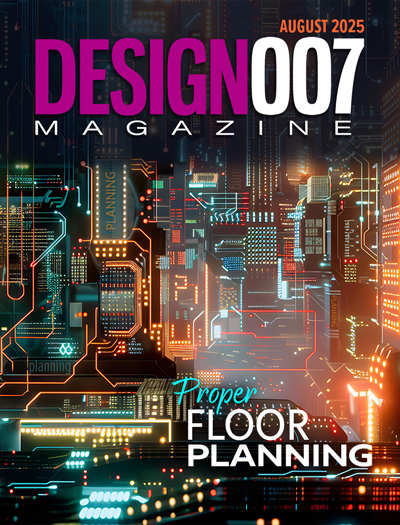-

- News
- Books
Featured Books
- design007 Magazine
Latest Issues
Current Issue
Power Integrity
Current power demands are increasing, especially with AI, 5G, and EV chips. This month, our experts share “watt’s up” with power integrity, from planning and layout through measurement and manufacturing.

Signal Integrity
If you don’t have signal integrity problems now, you will eventually. This month, our expert contributors share a variety of SI techniques that can help designers avoid ground bounce, crosstalk, parasitic issues, and much more.

Proper Floor Planning
Floor planning decisions can make or break performance, manufacturability, and timelines. This month’s contributors weigh in with their best practices for proper floor planning and specific strategies to get it right.
- Articles
- Columns
- Links
- Media kit
||| MENU - design007 Magazine
Freedom CAD Ready for Future With New Leadership
June 27, 2024 | Andy Shaughnessy, Design007 MagazineEstimated reading time: 5 minutes
During PCB East, I caught up with our friend Scott Miller of Freedom CAD. Scott has been chief operating officer of the company for quite a while, but he recently assumed a new title as new, younger managers moved up into top leadership positions. I asked Scott to discuss his new role, as well as the company’s move to keep looking at the industry in novel, fresh ways.
Andy Shaughnessy: Scott, I understand you have a new title, chief customer officer. What exactly does that entail?
Scott Miller: I'm transitioning out of the COO role into the chief customer officer role because of my relationships in the customer world. We just recognized that if we're going to continue to grow, we have to rejuvenize the business with youth. Our company is now 21 years old, and the senior leadership of the company is all maturing. So, for the past year or so, we’ve been restaffing. We’ve promoted Brian White to CEO and Pat White to COO. They are the sons of the founders of Freedom CAD, Lou and Lauren Primmer, and they've really stepped into their roles and are now leading the organization.
Shaughnessy: I met Brian and Pat in your booth, and I bet they’re about half my age.
Miller: Yes, they are young. We just need to adapt and figure out how to do things in a new way. They bring a whole new perspective to marketing, and to where the business direction needs to be so we don’t get stale. This is something we've been planning to do. We've groomed Brian and Pat over the years to embrace these responsibilities. Now I get to spend all of my time being customer-focused.
Shaughnessy: And that's what you like doing anyway, right?
Miller: Exactly. I enjoy working with customers.
Shaughnessy: That's great. Switching gears, what do you see going on in the industry right now? What are your challenges and your customers’ challenges?
Miller: It's an interesting time. Business is still strong, but we do see things slowing down a bit, which is not unexpected. We traditionally provide overflow support for our customers. As a design service bureau, we end up filling the gaps on the way up, and we step aside on the way down when business retrenches. Things are slowing a little bit, but we've been through this many times. Companies resize, people retire, there are reorgs, and then the business comes back. The next thing you know, they don't have enough capacity and they're knocking on our door again. So, we're holding our own. I wouldn't say that we're slow, but we're not busting at the seams.
Shaughnessy: In your position, you all are the first ones to see a slowdown or boom in business.
Miller: That’s right. We live it. And from a technology standpoint, it's always about smaller and denser. Managing power is very important. We're doing signal integrity on more projects, and power can affect signal performance with voltage shifts. We're doing thermal analysis because components are driving more power and we want to understand what's going on in the systems.
Our business has always been driven by complexity. We take on the tough stuff, so we see a lot of technology early and we have to figure out how to adapt to it. We're seeing some HDI, and some customers are talking about additive processes. We continue to educate ourselves so that we can be not just a service, but also a valuable resource for our customers. We always want to do more than just connect the dots.
And we're all challenged by the fact that this is a graying industry. There are a lot of maturing engineers and designers, and it's hard to find talented, young designers. We've established a program to bring in and train new designers. We’ve been very successful at doing that, maybe too successful [laughs]! Some of our best design trainees have turned into FAEs for EDA companies. Sometimes you pay the price of doing a good job.
Shaughnessy: Even if they leave, at least they’re educated and not out spreading misinformation.
Miller: That’s right. We’re good for the industry.
Shaughnessy: Are you watching any other new technologies?
Miller: We're keeping an eye on AI. A lot of the presentations at PCB East have been focused on AI. It’s clear that machine learning and AI are going to impact printed circuit board design, whether it's through interactive autorouting or some form of streamlining the process. So as a company, we are trying to make sure that we're aware of what's emerging and we're staying in pace with it. It seems like there's a big drive to the cloud and cloud designs, as well as how all of that is going to be managed. It'll be interesting to see.
A big part of AI is that it has to learn from data, right? And in our industry, the components change so fast. The technology changes constantly, and I think it’s going to be tough for the AI architecture to keep up. It's one thing for AI to write an article, but it's a whole different thing to design a schematic or a PCB. We’re a mature industry now, and the technology leaps aren't as dramatic as they used to be. But AI looks like it could have a dramatic effect.
Shaughnessy: Anything else you’d like to add?
Miller: I think we're well-positioned for the future as we monitor the evolving landscape and keep our design team well-trained.
Shaughnessy: Sounds good, Scott. Thanks for speaking with me.
Miller: Anytime, Andy.
Scott Miller is the author of The Printed Circuit Designer’s Guide to Executing Complex PCBs, available for free download. Audio book also available.
Testimonial
"We’re proud to call I-Connect007 a trusted partner. Their innovative approach and industry insight made our podcast collaboration a success by connecting us with the right audience and delivering real results."
Julia McCaffrey - NCAB GroupSuggested Items
The Chemical Connection: Onshoring PCB Production—Daunting but Certainly Possible
10/22/2025 | Don Ball -- Column: The Chemical ConnectionIn the past year, several potential customers, concerned about the impending application of tariffs on incoming goods, have asked us what it would take to bring their circuit board production back to the U.S. While they also had other considerations, the threat of new tariffs was the tipping point that started them thinking about the economic advantages of bringing their manufacturing back onshore. It might be interesting to relate our experiences with two of those inquiries.
Waging the Battle for American PCB Reshoring
10/21/2025 | Marcy LaRont, PCB007 MagazineLegislation is shaping global trade, tariffs, and sustainability and environmental regulations. David Schild of PCBAA discusses exactly where the U.S. stands in its efforts to reshore printed circuit board manufacturing for critical industries. This conversation at PCB West occurred on the first day of the federal government’s shutdown, so it seemed especially timely to hear David's thoughts and insights on how the current political climate is affecting efforts to achieve the U.S. industry’s reshoring goals.
The Right Approach: Electro-Tek—A Williams Family Legacy, Part 1
10/15/2025 | Steve Williams -- Column: The Right ApproachThere is no bronze bust in the lobby or portrait in the conference room of Electro-Tek's founder—my Dad, Charles “Chuck” Williams—so with the facility closing last year after 56 years, I feel it is time to tell the story. Chuck Williams founded Electro-Tek in 1968 in our basement, eventually moving into the second floor of an old 1913 building in downtown Milwaukee that is still standing (the first of three eventual facilities).
ICT Symposium Review: Sustainability and the Circular Economy
10/09/2025 | Pete Starkey, I-Connect007It was pleasant autumnal weather as we made our way once again to Meriden, the nominal centre of England, for the 2025 Annual Symposium of the Institute of Circuit Technology. Delegates were welcomed by technical director Emma Hudson who introduced and moderated a skilfully coordinated programme, focused on the highly relevant theme of sustainability.
Hardware Engineers, Manufacturing Leaders Ready to ‘Build Better’ Electronics
10/06/2025 | Marcy LaRont, I-Connect007According to Instrumental’s dynamic CEO, Anna-Katrina Shedletsky, the Build Better Electronics Manufacturing Summit on Sept. 30 was a passion project meant to provide a forum for hardware engineering senior leadership, who have very busy jobs and limited opportunities, to share information, thought leadership, and networking opportunities. “Build Better is really about cross-pollination and sharing,” she said, as she highlighted the importance of supporting this type of sharing in tech, which may be more important than ever before.


